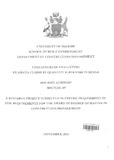| dc.description.abstract | The common use of lump sumjcontracts in Kenya, based on Joint Building Council (J.B.C) standard form of contract does not allow for ex-gratia claim since it is not contractual. However, as has been established in a survey done in Thailand, ex-gratia claims does not occur often in a project but when it occurs its impact is significant especially to the execution of the works by the contractor. The challenge therefore is for Quantity Surveyors to respond to ex-gratia claims when submitted. The response would be to evaluate the ex-gratia claim which may result in either its recommendation for an award or its rejection and therefore one would have to decide which method (s) to use, what factors to consider in awarding or rejecting etc.
The objectives for this study were to identify methods used by Quantity Surveyors in evaluating ex- gratia claims, secondly to identify the factors considered by Quantity Surveyors in recommending payment of ex-gratia claims and thirdly identifying the challenges faced by Quantity Surveyors in evaluating ex-gratia claims. The researcher considered that the above objectives would be able to capture the challenges faced by Quantity Surveyors in evaluating ex-gratia claims.
Literature review was done that provided input to the study methodology. The methodology of the study was a combination of both qualitative and quantitative types of research because although our data is historical it was to be presented in pie charts, percentages etc. The population for the study was all practicing Quantity Surveying firms in Kenya, the list was obtained from the Board of Registration of Architects and Quantity Surveyors (BORAQS). The list had an updated number of 152 firms out of which the study randomly sampled and obtained 45 firms. Questionnaire was chosen as a data collection instrument and therefore engaged two research assistants to help in the distribution and collection of questionnaires from the various respondents. Out of the 45 respondents, 30 firms responded to the questionnaires which represented 66.67% which is statistically adequate to represent the entire population. The data obtained was analyzed through Statistical Package for the Social Sciences (SPPS) computer programme and the results presented in terms of tables, figures and percentages.
for commercial and institution projects which were at 30.3% and 23.0% respectively. The study findings shows that the main cause of financial type of ex-gratia claim was fluctuations in a nonfluctuating
project and this represented 60% of the responses. On the other hand pricing error is also another contributing factor which represented 36.7% of all responses. This means that the two major causes of ex-gratia claims which are financial in nature are fluctuation and pricing errors. The three methods that the study found as being used to evaluate the financial type of ex-gratia claim were use of prevailing financial markets, the use of markets rates and the se of Joint Building Council price indices. On the other hand the major cause of time based ex-gratia claim was late delivery of imported materials and equipments, followed by cash flow problems, delay of works by a subcontractor and unavailability of local construction materials. The commonly used methods to evaluate ex-gratia claim as established by the study were use of scope of works remaining, works programme as well as the target date given by the client beyond which the project should have been handed over and running. The study also found out that the major challenge in evaluating any of the ex-gratia claims is lack of facts, lack of knowledge on ex-gratia claims as well as limited time to carry out the evaluation. Indeed, comprehensiveness and completeness of a claim document based on factual support was established as one of the key factors influencing whether the Quantity Surveyor would award or deny ex-gratia claim.
The study concluded that Quantity Surveyors be allowed to insert an addendum to the standard forms of contract to allow for ex-gratia claim. Secondly, the study also concluded that the methods used to evaluate contractual claims are the same as those ones used to evaluate ex-gratia claims.
Flowing from above, the study recommended several things; first that ex-gratia claims be incorporated as part of cost management strategies by Quantity Surveyors, secondly, that methods used to evaluate contractual claims should also be used to evaluate ex-gratia claims, thirdly that contingency sums for non-fluctuating contracts be more than the ones for fluctuating contracts and lastly that both the contractors and Quantity Surveyors create a culture of building data base for all their projects. | en_US |



